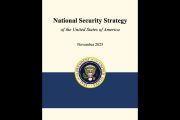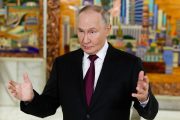
On March 27, Russian President Vladimir Putin said that if U.S.-made fighter jets make it to Ukraine, Russia will destroy them just as it has done to other Western equipment so far.
Various NATO members have promised to donate their F-16s to Kyiv and have trained Ukrainian pilots to fly them, but no deliveries have been made thus far. Russia has repeatedly warned the West that fielding the nuclear-capable jets will be a provocative escalation of the Ukraine conflict.
“If they deliver the F-16s, I think you know better than others that this will not change the situation on the battlefield,” the president said. “And we will destroy these planes just as we have destroyed tanks, armored vehicles and other equipment, including multiple launch rocket systems.”
The comments came during Putin’s visit to the Torzhok Air Base in Tver Region, home of the 344th Training Center for Russian combat pilots, including personnel being trained to take part in the Ukraine conflict.
Should the F-16s flown by Ukrainian pilots end up stationed in third countries, they will be legitimate targets for Russian aviation, Putin warned.
“Of course, if they are used from airfields of third countries, they become a legitimate target for us, wherever they are located,” the Russian president declared.
Russia is well aware that the fourth-generation fighter jet can potentially carry nuclear weapons, and this will be taken into account in combat operations, he elaborated.
Kyiv has lost much of its air force over the past two years, including the Soviet-era jets donated by several NATO members as replacements. The Ukrainian government eventually requested F-16s from the U.S.-led military alliance.
The single-engine fighter is a late 1970s design, originally manufactured by General Dynamics before it was acquired by Lockheed Martin. It requires pristine runways, which are in short supply in Ukraine, prompting speculation that Ukrainian-operated jets might be based in nearby NATO countries instead.
In an article this month, The New York Times reported that NATO member states will not be able to fulfill their pledge to send 45 F-16s to Ukraine, as the bloc’s drive to provide Kyiv with the U.S.-designed fighter jets is plagued by “confusion and chaos.”
The administration of U.S. President Joe Biden permitted America’s European allies to arm the Ukrainian military with F-16 aircraft last spring, with Denmark, the Netherlands, Norway, and Belgium jointly vowing to supply 45 planes.
However, only the Danish authorities have so far unveiled a timeline for the arrival of the jets in Ukraine, the Times said. Copenhagen says Kyiv will receive six F16s in late spring, with another 13 coming later in the year and in 2025.
Nonetheless, even if Ukraine receives all 45 promised aircraft, it still does not have nearly enough pilots to fly them, the Times admitted.
Presently, only 12 Ukrainian airmen are poised to be ready to operate the aircraft in combat by summer, it said.
As per the Times, the pilots, who are accustomed to flying Soviet-era warplanes, have been trained at “lightning speed” in Denmark, the United States, and the U.K. over the past 10 months.
Their training was complicated by the fact that they had to learn not just NATO’s flying techniques and tactics, but also English, it added.
Besides, the need to refurbish Ukraine’s “aging and war-damaged” airfields so that they are able to accommodate the F-16s is another problem that could delay the entry of the aircraft into battle, the Times acknowledged.
In another article, news outlet Politico warned that operating the F-16s will be challenging for the Kyiv regime.
The planes and their bases will be prime targets for Russian forces, Politico said, adding that unprepared runways could “sabotage the delicate aircraft,” while repairing the F-16 is a challenging task.
Russian Senator Aleksey Pushkov, who previously served as the head of the Foreign Affairs Committee in the State Duma, said in late February that “the F-16 will not change the course of fighting or the overall balance of forces [in the conflict between Moscow and Kyiv]. But the risk of a direct clash between Russia and NATO is increasing.”
Last year, Putin warned that the F-16s will “burn” once they are delivered to Ukraine, just like the Leopard-2 tanks, Bradley fighting vehicles, M1-A1 Abrams tanks, Patriot missile systems, and other Western-made weapons that have been supplied to Kyiv.
In February this year, former Russian president Dmitry Medvedev cautioned that supplying Ukraine with F-16 fighter jets poses a risk of igniting a nuclear conflict,
“An accidental, unintentional outbreak of a nuclear conflict is not something to be discarded, which is why all those machinations around Ukraine are dangerous,” Medvedev said in an extensive interview with Russian journalists, as quoted by TASS.
The deputy head of Russia’s National Security Council cited the U.S.-designed aircraft as a possible catalyst for a nuclear conflict, noting that Kyiv wants them despite having no ground infrastructure to operate them.
“So if one of those planes takes off from a NATO nation [on a Ukrainian mission] — what would that be? An attack on Russia. I shall not describe what could happen next,” he said. “Such a development may not be even sanctioned by the NATO leadership and the US.”
Medvedev said Russia’s face-off with the United States and its allies was not at a stage that would force people to hide in a nuclear shelter, but described it as worse than the 1962 Cuban Missile Crisis. The doomsday clock “is ticking” and has “sped up considerably,” he added.
The doomsday clock — a representation of the likelihood of a global catastrophe maintained by the Bulletin of the Atomic Scientists — is presently 90 seconds to midnight, having advanced 10 seconds last year.
In July last year, Russian Foreign Minister Sergey Lavrov declared that his country could not ignore the nuclear capability of the F-16 fighter jets that may be supplied to Ukraine by its Western backers. By continuing to provide more sophisticated arms to Kiev, “the US and its NATO satellites create the risk of a direct armed confrontation with Russia, and this may lead to catastrophic consequences,” Lavrov warned in his interview with Lenta.ru.
“We have informed the nuclear powers — the US, UK and France — that Russia can’t ignore the ability of these aircraft to carry nuclear weapons,” the foreign minister continued.
“No assurances [by the West] will help here,” he warned.




